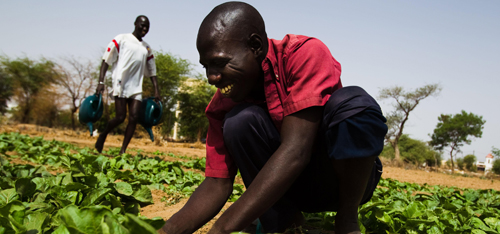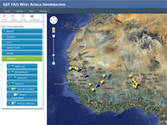Reducing dependence on POPs and other agrochemicals in the Senegal and Niger River Basins through integrated production, pest and pollution management
FAO and its partners are pilot testing tools and methods to monitor pesticides in the Niger and Senegal River watersheds and to estimate quantitative levels of risk to biodiversity and human-health across Benin, Guinea, Mali, Mauritania, Niger and Senegal.
To this end, the multi-disciplined project “Reducing dependence on POPs and other agrochemicals in the Senegal and Niger river basins through integrated production, pest and pollution management” (EP/INT/606/GEF) is the first large-scale effort to comprehensively monitor pesticide use in agriculture in sub-Saharan Africa. Simultaneously, the project is continuing the work of the IPPM programme to build safe, productive and sustainable agricultural systems via farmer field schools.
The five-year project, running from 2009 to 2014, has conducted community baseline pesticide-use surveys and baseline water pollution sample surveys.
The project is piloting a new technology for the first time in Africa called a “passive sampling device” (PSD), which adsorbs target chemicals when submerged in a stainless steel cage for approx. two weeks. The device is light-weight, temperature-stable and easily transported. Technicians from Oregon State University (OSU) have collaborated with CERES Locustox Laboratory, a local partner in Senegal, to build capacity to prepare, deploy and analyse results from the PSDs. A quality assurance plan for sampling and analysis has been developed that can also be used in other labs in Africa.
PSDs were deployed in 19 locations in six countries along the Senegal and Niger Rivers and these have detected pesticide residues, including several POPs.
In separate research, a state-of-the-art computer model, called ipmPRiME has been adapted for use in the West African context. The model is an environmental risk assessment tool that was developed by a consortium of actors in North America, led by OSU. It uses the farmer pesticide-use surveys to provide quantitative risk estimates to key indicator groups of aquatic and terrestrial species, plus indicators of human health risks.
This combined method has enabled detailed, multi-scale risk assessments to be undertaken in the 19 watersheds across the six countries and revealed alarmingly high and widespread risks from pesticides to human health and to aquatic and terrestrial species.
To provide access to the data and results from both PSD and ipmPRiME in the various project locations, a data management system (DMS) was created by OSU. The system provides a series of interpretative and interactive tools for collaborators and stakeholders.
Risk communication
The project brings high-quality scientific tools to West Africa, however, the outputs from the analyses need to be made relevant and accessible to a range of stakeholders, beginning with the communities who are most at risk. Transmitting an understanding of the risks found from pesticides in an ethical and balanced manner, that further leads to good decisions, is a challenge. Currently, OSU is working with FAO and stakeholders to develop and test a range of risk communication tools and activities. While progress is being made, more work is required to protect the health of communities and the environment from toxic pesticides, while improving production and profitability at the same time.
Sustainable intensification through IPPM / FFS activities
To facilitate the adoption by farmers of alternative practices that reduce or eliminate the use of moderately to highly toxic pesticides without loss to productivity, the project relies on the proven Integrated Production and Pest Management (IPPM) approach.
The IPPM approach encourages farmers to eliminate the use of highly hazardous pesticides in favour of low-toxicity alternatives. Simultaneously, they receive hands-on training to improve a wide range of agronomic practices, helping them to boost yields, improve profitability, and enhance economic and environmental resilience.
Partners
FAO is working with various partners in this initiative, including: Oregon State University Integrated Pest Management Center (IPPC); CERES Locustox Laboratory; ENDA-Pronat group in Senegal and analytical laboratories in the region.
FAO is grateful to the Global Environmental Facility (GEF), the Government of the Netherlands, the Government of Sweden, the European Union and the United Nations Environment Programme (UNEP) for their support to this project.


